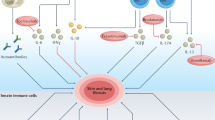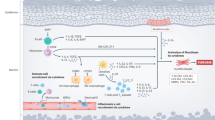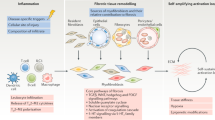Abstract
Systemic sclerosis (SSc), also known as scleroderma, is a complex connective tissue disease that is associated with a high mortality and is challenging to treat because of its clinical heterogeneity and a lack of effective antifibrotic therapies. SSc has vascular, immunologic and fibrotic components that are pathologically interconnected. A growing understanding of the molecular and cellular mechanisms that underlie SSc pathogenesis provides logical and novel approaches to treatment. At present most therapies are organ-based. Vascular and inflammatory components of the disease can also be treated, but effective antifibrotic therapies are lacking. A number of key molecular mediators have the potential to alter immune-cell, vascular and fibrotic processes and these mediators, which include transforming growth factor-β isoforms, endothelin-1, connective-tissue growth factor, chemokines and members of the interleukin family, are attractive targets for therapeutic modulation. Key mediators can be blocked using antibodies, soluble receptors, endogenous inhibitors or small-molecule antagonists of ligands, receptors or signaling intermediates. Overall, this is an exciting time for new therapies in SSc and advances are being made in synchrony with an improved understanding of the molecular and biochemical basis of the disease.
Key Points
-
The clinical heterogeneity of systemic sclerosis probably reflects differential activity of vascular, immunologic and connective-tissue pathology
-
Immunosuppression with cyclophosphamide might be effective in pulmonary fibrosis associated with systemic sclerosis but needs to be balanced against toxicity
-
Management of organ-based complications is more successful than current disease-modifying treatment and so patients should be actively screened for complications
-
Understanding pathogenesis and identifying pivotal mediators or key signaling pathways might allow logical targeted therapy in the future
This is a preview of subscription content, access via your institution
Access options
Subscribe to this journal
Receive 12 print issues and online access
$209.00 per year
only $17.42 per issue
Buy this article
- Purchase on Springer Link
- Instant access to full article PDF
Prices may be subject to local taxes which are calculated during checkout


Similar content being viewed by others
References
Denton CP and Black CM (2004) Scleroderma—clinical and pathological advances. Best Pract Res Clin Rheumatol 18: 271–290
Merkel PA et al. (2002) Measuring disease activity and functional status in patients with scleroderma and Raynaud's phenomenon. Arthritis Rheum 46: 2410–2420
Apras S et al. (2003) Effects of oral cyclophosphamide and prednisolone therapy on the endothelial functions and clinical findings in patients with early diffuse systemic sclerosis. Arthritis Rheum 48: 2256–2261
Pope JE et al. (2001) A randomized, controlled trial of methotrexate versus placebo in early diffuse scleroderma. Arthritis Rheum 44: 1351–1358
Takehara K (2003) Hypothesis. Pathogenesis of systemic sclerosis. J Rheumatol 30: 755–759
Flavahan NA et al. (2003) The vasculopathy of Raynaud's phenomenon and scleroderma. Rheum Dis Clin North Am 29: 275–291
Lunardi C et al. (2000) Systemic sclerosis immunoglobulin G autoantibodies bind the human cytomegalovirus late protein UL94 and induce apoptosis in human endothelial cells. Nat Med 6: 1183–1186
Worda M et al. (2003) In vivo analysis of the apoptosis-inducing effect of anti-endothelial cell antibodies in systemic sclerosis by the chorionallantoic membrane assay. Arthritis Rheum 48: 2605–2614
Distler O et al. (2004) Uncontrolled expression of vascular endothelial growth factor and its receptors leads to insufficient skin angiogenesis in patients with systemic sclerosis. Circ Res 95: 109–116
Del Papa N et al. (2004) Circulating endothelial cells as a marker of ongoing vascular disease in systemic sclerosis. Arthritis Rheum 50: 1296–1304
Liu X et al. (2005) Paclitaxel modulates TGFβ signaling in scleroderma skin grafts in immunodeficient mice. PLoS Med 2: e354
Kuwana M et al. (2003) HLA class II alleles in systemic sclerosis patients with anti-RNA polymerase I/III antibody: associations with subunit reactivities. J Rheumatol 30: 2392–2397
Sato H et al. (2004) The TNF-863A allele strongly associates with anticentromere antibody positivity in scleroderma. Arthritis Rheum 50: 558–564
Henault J et al. (2004) Direct binding of anti-DNA topoisomerase I autoantibodies to the cell surface of fibroblasts in patients with systemic sclerosis. Arthritis Rheum 50: 3265–3274
Ahmed SS and Tan FK (2003) Identification of novel targets in scleroderma: update on population studies, cDNA arrays, SNP analysis, and mutations. Curr Opin Rheumatol 15: 766–771
Sato S et al. (2001) Clinical significance of anti-topoisomerase I antibody levels determined by ELISA in systemic sclerosis. Rheumatology (Oxford) 40: 1135–1140
Carvalho D et al. (1996) IgG antiendothelial cell autoantibodies from scleroderma patients induce leukocyte adhesion to human vascular endothelial cells in vitro. Induction of adhesion molecule expression and involvement of endothelium-derived cytokines. J Clin Invest 97: 111–119
Sato S et al. (2004) Altered B lymphocyte function induces systemic autoimmunity in systemic sclerosis. Mol Immunol 41: 1123–1133
Bouros D et al. (2002) Histopathologic subsets of fibrosing alveolitis in patients with systemic sclerosis and their relationship to outcome. Am J Respir Crit Care Med 165: 1581–1586
Sappino AP et al. (1990) Smooth muscle differentiation in scleroderma fibroblastic cells. Am J Pathol 137: 585–591
Mimura Y et al. (2005) Constitutive phosphorylation of focal adhesion kinase is involved in the myofibroblast differentiation of scleroderma fibroblasts. J Invest Dermatol 124: 886–892
Laplante P et al. (2005) Novel fibrogenic pathways are activated in response to endothelial apoptosis: implications in the pathophysiology of systemic sclerosis. J Immunol 174: 5740–5749
Postlethwaite AE et al. (2004) Cellular origins of fibroblasts: possible implications for organ fibrosis in systemic sclerosis. Curr Opin Rheumatol 16: 733–738
Rajkumar V et al. (2005) Shared expression of phenotypic markers indicates a convergence of pericytes and fibroblasts to a myofibroblast lineage in fibrosis. Arthritis Res 7: R1113–R1123
Denton CP and Abraham DJ (2001) Transforming growth factor-β and connective tissue growth factor: key cytokines in scleroderma pathogenesis. Curr Opin Rheumatol 13: 505–511
Leask A et al. (2002) Connective tissue growth factor: a new and important player in the pathogenesis of fibrosis. Curr Rheumatol Rep 4: 136–142
Mayes MD (2003) Endothelin and endothelin receptor antagonists in systemic rheumatic disease. Arthritis Rheum 48: 1190–1199
Ong VH et al. (2003) Monocyte chemoattractant protein 3 as a mediator of fibrosis: overexpression in systemic sclerosis and the type 1 tight-skin mouse. Arthritis Rheum 48: 1979–1991
Kawaguchi Y et al. (2003) Identification of an IL1A gene segment that determines aberrant constitutive expression of interleukin-1α in systemic sclerosis. Arthritis Rheum 48: 193–202
Asano Y et al. (2004) Impaired Smad7-Smurf-mediated negative regulation of TGF-β signaling in scleroderma fibroblasts. J Clin Invest 113: 253–264
Mori Y et al. (2003) Expression and regulation of intracellular SMAD signaling in scleroderma skin fibroblasts. Arthritis Rheum 48: 1964–1978
Clements PJ et al. (2004) High-dose versus low-dose D-penicillamine in early diffuse systemic sclerosis trial: lessons learned. Semin Arthritis Rheum 33: 249–263
Seibold JR (2001) Clinical trials: types, design, and end-points. Curr Opin Rheumatol 13: 512–515
Carbone LD et al. (2004) Dosage effects of orally administered bovine type I collagen on immune function in patients with systemic sclerosis. Arthritis Rheum 50: 2713–2715
Denton CP et al. (2004) Anti-TGFβ1 therapy for diffuse cutaneous systemic sclerosis: a multicenter, randomized, placebo-controlled Phase I/II trial of CAT-192 [abstract #1851]. Arthritis Rheum 50 (Suppl 9): S691
Tyndall A and Matucci-Cerinic M (2003) Haematopoietic stem cell transplantation for the treatment of systemic sclerosis and other autoimmune disorders. Expert Opin Biol Ther 3: 1041–1049
Desai SR et al. (2004) CT features of lung disease in patients with systemic sclerosis: comparison with idiopathic pulmonary fibrosis and nonspecific interstitial pneumonia. Radiology 232: 560–567
Airo P et al. (2004) Intravenous cyclophosphamide therapy for systemic sclerosis. A single-center experience and review of the literature with pooled analysis of lung function test results. Clin Exp Rheumatol 22: 573–578
Tashkin DP (2005) Major outcomes of SLS [abstract #B27]. American Thoracic Society International Conference, San Diego, May 2005
Highland KB and Silver RM (2005) Clinical aspects of lung involvement: lessons from idiopathic pulmonary fibrosis and the scleroderma lung study. Curr Rheumatol Rep 7: 135–141
Khanna D et al. (2005) Correlation of the degree of dyspnea with health-related quality of life, functional abilities, and diffusing capacity for carbon monoxide in patients with systemic sclerosis and active alveolitis: results from the Scleroderma Lung Study. Arthritis Rheum 52: 592–600
Mukerjee D et al. (2003) Prevalence and outcome in systemic sclerosis associated pulmonary arterial hypertension: application of a registry approach. Ann Rheum Dis 62: 1088–1093
Steen V and Medsger TA Jr (2003) Predictors of isolated pulmonary hypertension in patients with systemic sclerosis and limited cutaneous involvement. Arthritis Rheum 48: 516–522
Yap LB et al. (2004) The natriuretic peptides and their role in disorders of right heart dysfunction and pulmonary hypertension. Clin Biochem 37: 847–856
Allanore Y et al. (2003) N-terminal pro-brain natriuretic peptide as a diagnostic marker of early pulmonary artery hypertension in patients with systemic sclerosis and effects of calcium-channel blockers. Arthritis Rheum 48: 3503–3508
Farber HW and Loscalzo J (2004) Pulmonary arterial hypertension. N Engl J Med 351: 1655–1665
Hachulla E and Coghlan JG (2004) A new era in the management of pulmonary arterial hypertension related to scleroderma: endothelin receptor antagonism. Ann Rheum Dis 63: 1009–1014
Denton CP et al. (2005) Bosentan therapy for pulmonary arterial hypertension related to systemic sclerosis [abstract]. Ann Rheum Dis 64 (Suppl 3): 294
Steen VD et al. (1990) Outcome of renal crisis in systemic sclerosis: relation to availability of angiotensin converting enzyme (ACE) inhibitors. Ann Intern Med 113: 352–357
Denton CP et al. (1994) Acute renal failure occurring in scleroderma treated with cyclosporin A: a report of three cases. Br J Rheumatol 33: 90–92
Steen VD and Medsger TA Jr (1998) Case–control study of corticosteroids and other drugs that either precipitate or protect from the development of scleroderma renal crisis. Arthritis Rheum 41: 1613–1619
DeMarco PJ et al. (2002) Predictors and outcomes of scleroderma renal crisis: the high-dose versus low-dose D-penicillamine in early diffuse systemic sclerosis trial. Arthritis Rheum 46: 2983–2989
Saccardi R et al. (2004) Consensus statement concerning cardiotoxicity occurring during haematopoietic stem cell transplantation in the treatment of autoimmune diseases, with special reference to systemic sclerosis and multiple sclerosis. Bone Marrow Transplant 34: 877–881
Jaovisidha K et al. (2005) Severe gastrointestinal involvement in systemic sclerosis: report of five cases and review of the literature. Semin Arthritis Rheum 34: 689–702
Kenefick NJ et al. (2002) Sacral nerve stimulation for faecal incontinence due to systemic sclerosis. Gut 51: 881–883
Calamia KT et al. (2000) Endoscopic YAG laser treatment of watermelon stomach (gastric antral vascular ectasia) in patients with systemic sclerosis. Clin Exp Rheumatol 18: 605–608
Yusoff I et al. (2002) Argon plasma coagulation for treatment of watermelon stomach. Endoscopy 34: 407–410
Author information
Authors and Affiliations
Corresponding author
Ethics declarations
Competing interests
Christopher P Denton has received research funding and acted as an external consultant to Actelion Pharmaceuticals, Genzyme Inc., Aspreva Pharmaceuticals and Encysive Pharmaceuticals. Carol M Black has received research funding, been on advisory boards, and has been an invited lecturer for Actelion Pharmaceuticals, Genzyme Inc., and Serono Pharmaceuticals. David J Abraham has declared no competing interests.
Rights and permissions
About this article
Cite this article
Denton, C., Black, C. & Abraham, D. Mechanisms and consequences of fibrosis in systemic sclerosis. Nat Rev Rheumatol 2, 134–144 (2006). https://doi.org/10.1038/ncprheum0115
Received:
Accepted:
Issue Date:
DOI: https://doi.org/10.1038/ncprheum0115
This article is cited by
-
Microparticles: potential new contributors to the pathogenesis of systemic sclerosis?
Advances in Rheumatology (2023)
-
Clinical assessment of patients with systemic sclerosis: is there a place for thermography?
Archives of Dermatological Research (2022)
-
Dualities of the vitamin D in systemic sclerosis: a systematic literature review
Advances in Rheumatology (2021)
-
Global gene expression analysis of systemic sclerosis myofibroblasts demonstrates a marked increase in the expression of multiple NBPF genes
Scientific Reports (2021)
-
Efficacy and safety of rituximab on lung and skin involvement in systemic sclerosis: a systematic review and metaanalysis
Clinical Rheumatology (2021)



